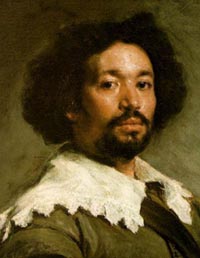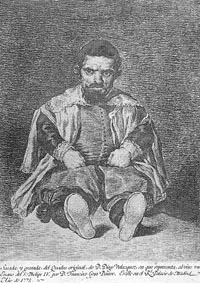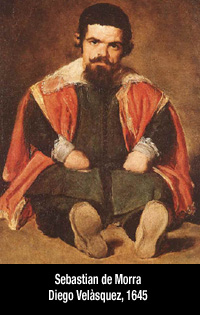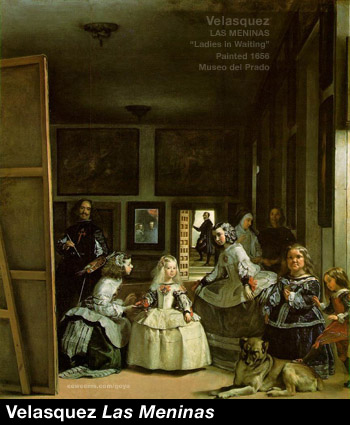Goya and Velàsquez
Diego Velasquez "the faultless painter"
(Page 7, The World of Goya, by Richard Schickel, Time-Life Books 1968)
(Page 19, Goya, by Robert Hughes, published by Alfred Knopf, 2003) Goya and Velasquez
Goya claimed that his teachers were "nature, Rembrandt and Velasquez." (Page 22, Goya, by Bernard L. Myers, Spring Books, 1964) Goya made a number of copies of Velasquez images. The list below is based on the "Complete Etchings of Goya" book, miscellany appendix:
A
Comparison
For
Goya's
portrait
of Francisco
de
Cabarrus (1788),
he
is
reported
to
have
studied
the
Velasquez
portrait
of Pablo
de
Valladolid (1636).
Click
on
the
images
below
to
compare:
Some background from biographers
Page 54, The World of Goya, by Richard Schickel, Time-Life Books 1968.
Page 73, Goya, by Sarah Symmons, Phaidon Press, 1998.
(Page 8, Goya, by Bernard L. Myers, Spring Books, 1964)
(Page 2 of the English language translation from Goya, Ediciones Minos, Museo del Prado, 1961) Note: You'll notice that the biographers disagree on how many direct copies Goya made from Velasquez. I have read that it is as few as six completed images; or nine images with only six surviving; Xavier de Salas book says 13 images, and as you would have read above, Schickels Time-Life book says 16 altogether. The book Complete Etchings of Goya (Crown Publishers), shows 18 etchings after Velasquez, with two being secondary versions (i.e., Goya apparently changed the printing method and emphasized features that are much weaker in the first state versions.)
Rarely, if ever before, has a painter referred so pointedly to the work of a predecessor. From "Goya's Portrait of the Royal Family," by Goya used the subject of the reflective powers of mirrors as a running theme through several pieces. Perhaps the most well known is his painting Las Vierjas (also called Que Tal? and simply Time). Fred Licht (among others) has pointed out the similarity of the flat rectangular mirror to the flat rectangular canvas, and how close the two are in function in certain pieces, especially Goya's The Family of King Carlos IV, where Goya seems to indicate that the viewer is in the position of a mirror upon which the subjects gaze, i.e., the painting is the mirrored reflection, not the actual setting (which, incidentally, includes Goya himself, much the way that the earlier great Spanish painter Velasquez had included himself into his painting Las Meninas). |
- - - - - - - - - - - - - - - - -
- - - - - - - - - - - - - - - - -
WEB
SITE COPYRIGHT©1997-2006 ERIK E. WEEMS
IMAGES ARE COPYRIGHT TO THEIR RESPECTIVE OWNERS
http://www.eeweems.com/goya/velasquez.html
BIO | ARTWORK | BOOKS | RESOURCES FOR STUDENTS | LINKS | CONTACT | NEWS | STATS | F.A.Q.








